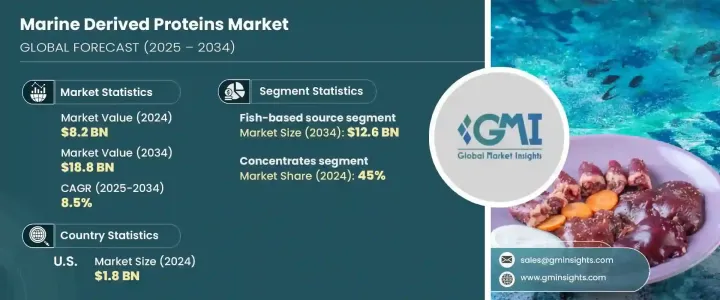PUBLISHER: Global Market Insights Inc. | PRODUCT CODE: 1685118

PUBLISHER: Global Market Insights Inc. | PRODUCT CODE: 1685118
Marine Derived Proteins Market Opportunity, Growth Drivers, Industry Trend Analysis, and Forecast 2025 - 2034
The Global Marine Derived Proteins Market, valued at USD 8.2 billion in 2024, is projected to expand at a CAGR of 8.5% between 2025 and 2034, driven by increasing consumer demand for high-quality, sustainable protein sources. This upward trend is fueled by the rising popularity of marine proteins, which are rich in essential amino acids, omega-3 fatty acids, and bioactive compounds. As health-conscious consumers seek nutrient-dense food options, marine proteins are emerging as a preferred choice across various dietary and functional applications.

Growing concerns over environmental sustainability and ethical food sourcing are also reshaping consumer preferences, leading to higher adoption of marine-derived proteins. These proteins provide a sustainable alternative to traditional animal-based proteins, particularly algae-based options, which align with plant-based and eco-conscious dietary movements. Additionally, advancements in food processing technologies are enhancing the bioavailability and functional benefits of marine proteins, making them more appealing for use in nutraceuticals, sports nutrition, and pharmaceutical applications.
| Market Scope | |
|---|---|
| Start Year | 2024 |
| Forecast Year | 2025-2034 |
| Start Value | $8.2 Billion |
| Forecast Value | $18.8 Billion |
| CAGR | 8.5% |
By source, the marine-derived proteins market is categorized into shellfish-based, fish-based, algae-based, and others. Fish-based proteins dominated the market, generating USD 5.5 billion in 2024 and projected to reach USD 12.6 billion by 2034. Their exceptional nutritional profile and versatile applications across food, pharmaceuticals, and cosmetics make them a key driver of market growth. Shellfish-based proteins are rapidly gaining traction due to their high bioavailability and widespread application in dietary supplements, pet nutrition, and functional foods. Algae-based proteins are witnessing an accelerated rise in demand as sustainable, plant-friendly alternatives, appealing to consumers looking for environmentally responsible protein sources. Their ability to deliver high protein content with minimal ecological impact makes them a strong competitor in the market.
In terms of form, the market is divided into concentrates, hydrolysates, and isolates. The concentrates segment held a dominant 45% share in 2024, driven by its affordability, ease of production, and balanced nutritional properties. Compared to isolates and hydrolysates, concentrates undergo minimal processing while retaining a significant portion of protein, making them an ideal choice for functional foods, beverages, and animal feed. Their widespread adoption across various industries underscores their cost-effectiveness and ability to meet evolving consumer needs.
The U.S. marine-derived proteins market was valued at USD 1.8 billion in 2024, with strong growth prospects driven by increasing interest in health and wellness products. Consumers are prioritizing high-quality protein sources rich in omega-3 fatty acids
and essential nutrients, contributing to surging demand for marine-based dietary supplements and functional foods. The expanding sports nutrition sector further supports this upward trajectory, as athletes and fitness enthusiasts seek clean, bioavailable protein sources. Additionally, sustainability concerns are influencing purchasing decisions, prompting manufacturers to develop eco-friendly marine protein solutions that align with environmentally conscious consumer preferences.
As the market continues to evolve, innovation in marine protein extraction, processing, and application is expected to accelerate growth. With consumers shifting toward nutritional and sustainable food choices, marine-derived proteins are set to become a crucial part of the global protein landscape, shaping the future of dietary and functional nutrition industries.
Table of Contents
Chapter 1 Methodology & Scope
- 1.1 Market scope & definition
- 1.2 Base estimates & calculations
- 1.3 Forecast calculation
- 1.4 Data sources
- 1.4.1 Primary
- 1.4.2 Secondary
- 1.4.2.1 Paid sources
- 1.4.2.2 Public sources
Chapter 2 Executive Summary
- 2.1 Industry synopsis, 2021-2034
Chapter 3 Industry Insights
- 3.1 Industry ecosystem analysis
- 3.1.1 Factor affecting the value chain
- 3.1.2 Profit margin analysis
- 3.1.3 Disruptions
- 3.1.4 Future outlook
- 3.1.5 Manufacturers
- 3.1.6 Distributors
- 3.2 Supplier landscape
- 3.3 Profit margin analysis
- 3.4 Key news & initiatives
- 3.5 Regulatory landscape
- 3.6 Impact forces
- 3.6.1 Growth drivers
- 3.6.1.1 Rich in essential nutrients
- 3.6.1.2 Improved athletic performance
- 3.6.1.3 Enhanced cognitive function
- 3.6.2 Industry pitfalls & challenges
- 3.6.2.1 Pollution and contaminants
- 3.6.1 Growth drivers
- 3.7 Growth potential analysis
- 3.8 Porter’s analysis
- 3.9 PESTEL analysis
Chapter 4 Competitive Landscape, 2024
- 4.1 Introduction
- 4.2 Company market share analysis
- 4.3 Competitive positioning matrix
- 4.4 Strategic outlook matrix
Chapter 5 Market Size and Forecast, By Source, 2021-2034 (USD Billion) (Kilo Tons)
- 5.1 Key trends
- 5.2 Fish-based
- 5.3 Shellfish-based
- 5.4 Algae-based
- 5.5 Other
Chapter 6 Market Size and Forecast, By Form, 2021-2034 (USD Billion) (Kilo Tons)
- 6.1 Key trends
- 6.2 Concentrates
- 6.3 Hydrolysates
- 6.4 Isolates
Chapter 7 Market Size and Forecast, By Distribution Channel, 2021-2034 (USD Billion) (Kilo Tons)
- 7.1 Key trends
- 7.2 Direct sales
- 7.3 Distributors
- 7.4 Retail
Chapter 8 Market Size and Forecast, By Region, 2021-2034 (USD Billion) (Kilo Tons)
- 8.1 Key trends
- 8.2 North America
- 8.2.1 U.S.
- 8.2.2 Canada
- 8.3 Europe
- 8.3.1 UK
- 8.3.2 Germany
- 8.3.3 France
- 8.3.4 Italy
- 8.3.5 Spain
- 8.3.6 Russia
- 8.4 Asia Pacific
- 8.4.1 China
- 8.4.2 India
- 8.4.3 Japan
- 8.4.4 South Korea
- 8.4.5 Australia
- 8.5 Latin America
- 8.5.1 Brazil
- 8.5.2 Mexico
- 8.6 MEA
- 8.6.1 South Africa
- 8.6.2 Saudi Arabia
- 8.6.3 UAE
Chapter 9 Company Profiles
- 9.1 Aker BioMarine
- 9.2 Aquaculture Protein
- 9.3 Biomega Group
- 9.4 Cargill
- 9.5 Cellulac
- 9.6 Corbion
- 9.7 DSM
- 9.8 Epax
- 9.9 FMC Corporation
- 9.10 Kerry Group
- 9.11 Lonza
- 9.12 Neptune Wellness Solutions
- 9.13 Nippon Suisan Kaisha
- 9.14 Royal Greenland
- 9.15 SkyBiometry




